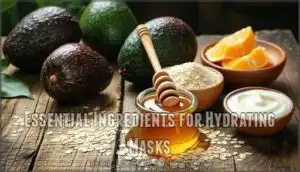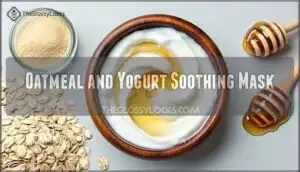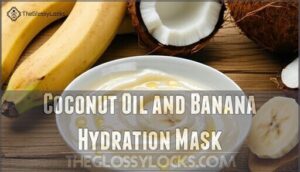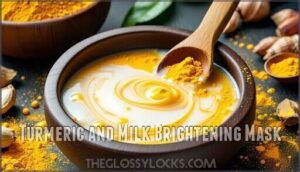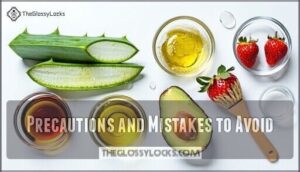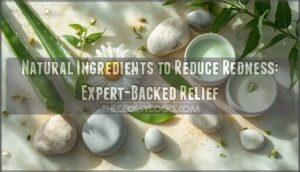This site is supported by our readers. We may earn a commission, at no cost to you, if you purchase through links.
 When your skin feels tight and flaky, you’re dealing with dryness that needs immediate moisture. A simple DIY face mask for dry skin can work wonders using ingredients from your kitchen.
When your skin feels tight and flaky, you’re dealing with dryness that needs immediate moisture. A simple DIY face mask for dry skin can work wonders using ingredients from your kitchen.
Try mashing half an avocado with one tablespoon of honey—the avocado provides rich oils while honey acts as a natural humectant, drawing moisture into your skin. Apply this mixture for 15 minutes, then rinse with lukewarm water. Oatmeal mixed with yogurt creates another gentle option that soothes irritation while hydrating.
Always patch test first to avoid reactions. The key lies in choosing ingredients that don’t just sit on your skin’s surface but actually penetrate and restore your natural moisture barrier.
Table Of Contents
- Key Takeaways
- Recognizing and Managing Dry Skin
- Essential Ingredients for Hydrating Masks
- Step-by-Step DIY Face Mask Recipes
- Proper Application and Usage Tips
- Precautions and Mistakes to Avoid
- Frequently Asked Questions (FAQs)
- What is a DIY face mask?
- How to get rid of dryness on face?
- What are the best DIY face masks for oily skin?
- What makes a good homemade face mask?
- Should you use a face mask if you have dry skin?
- How do you make a homemade face mask?
- What’s a good homemade face mask?
- What’s the best homemade face mask for acne?
- What is the best homemade facial mask for dry skin?
- Which face mask is best for dry skin?
- Conclusion
Key Takeaways
- You’ll get the best results by combining avocado’s rich oils with honey’s moisture-drawing properties – mash half an avocado with one tablespoon of honey and apply for 15 minutes to deeply hydrate parched skin.
- Always patch test any DIY mask on your wrist 24 hours before full application, as even natural ingredients can cause reactions on sensitive, dry skin.
- Apply masks to clean skin using upward strokes in an even layer, avoiding the delicate eye area, then follow with moisturizer while your skin’s still slightly damp for maximum hydration.
- Use these homemade masks 1-2 times weekly consistently rather than daily – over-treatment can actually worsen dryness and irritation by damaging your skin’s protective barrier.
Recognizing and Managing Dry Skin
If you’ve been dealing with tight, flaky, or rough-feeling skin, you’re likely experiencing dryness that needs targeted care.
Understanding what’s causing your dry skin helps you choose the right DIY mask ingredients to restore moisture and comfort effectively.
Common Causes of Dry Skin
Dry skin’s root causes span multiple factors that disrupt your skin’s natural moisture barrier. Genetic predisposition makes some people naturally prone to dryness, while underlying conditions like eczema, diabetes, or hypothyroidism reduce skin hydration.
Your skin’s moisture barrier holds the key to hydration—genetics and environment can make or break it
Environmental factors, including low humidity, harsh weather, and indoor heating, strip away protective oils. Dehydration effects from inadequate water intake compound the problem, and medication side-effects from diuretics or retinoids can worsen dryness substantially.
Environmental and Lifestyle Factors
Several environmental and lifestyle factors contribute to dry skin beyond genetics. Climate effects like low humidity, harsh winds, and extreme temperatures strip your skin’s natural moisture barrier. Pollution impact from smog and particulates creates free radicals that damage skin cells.
Your diet hydration, stress levels, and sleep quality directly affect skin health, as dehydration and increased cortisol worsen environmental damage.
Using a humidifier can help to combat indoor dry environments.
Identifying Dry Skin Symptoms
You’ll recognize dry skin by its telltale signs. Your skin texture feels rough and tight, especially after washing. Itchiness causes constant discomfort, while flaking severity varies from light dusting to visible patches. Redness indicators appear around problem areas, and sensitivity levels spike with weather changes.
Understanding your skin type helps determine appropriate dry skin care routines that address specific skin sensitivities effectively.
Essential Ingredients for Hydrating Masks
When your skin feels tight and flaky, the right ingredients can make all the difference in restoring moisture and comfort. Natural powerhouses like avocado, honey, oatmeal, and yogurt work together to hydrate parched skin while providing gentle nourishment your face craves.
Benefits of Avocado and Honey
Avocado and honey form a powerhouse duo for DIY face masks targeting dry skin. These natural ingredients deliver outstanding hydration and protection through their unique properties.
Here’s why this combination works so effectively:
- Avocado Hydration – Rich in omega-3 fatty acids and vitamin B, avocado penetrates deep to restore moisture barriers
- Honey Antibacterial properties prevent breakouts while acting as a natural humectant that draws moisture to skin
- Skin Nourishment occurs through avocado’s healthy fats that repair damaged skin cells
- Mask Efficacy improves when honey’s enzymes gently exfoliate while avocado softens rough patches
- Natural Humectants in honey maintain long-lasting hydration even after removing your homemade face mask
For best results, use raw, unfiltered honey in your mask.
Role of Oatmeal and Yogurt
Oatmeal Benefits shine through its gentle exfoliation and anti-inflammatory properties, making it perfect for Sensitive Skin that can’t handle harsh scrubs.
Yogurt Properties include natural probiotics that support skin health while providing gentle hydration. These Probiotic Effects help balance your skin’s microbiome.
Together, these ingredients create powerful Mask Combinations for effective DIY face masks targeting dry skin concerns.
Choosing Safe, Natural Additions
Beyond oatmeal and yogurt, you’ll want to select additional ingredients carefully for your homemade face mask. Safety matters when treating dry skin, so here’s your checklist:
- Patch test everything – Apply small amounts to your wrist 24 hours before using
- Choose organic certification when possible for cleaner ingredient sourcing
- Avoid common allergens like fragrance oils or botanical extracts you’re sensitive to
- Pick sustainable options like locally-sourced honey and aloe
- Start simple – combine just 2-3 ingredients initially
Sensitivity testing prevents reactions while organic ingredients minimize chemical exposure on delicate skin. You can also use ingredients with anti-inflammatory benefits to soothe irritated skin.
Step-by-Step DIY Face Mask Recipes
You’ll find these four proven recipes transform your dry skin using simple kitchen ingredients.
Each mask combines moisture-rich elements with gentle, nourishing properties that work together to restore your skin’s natural hydration balance.
Avocado and Honey Moisturizing Mask
Mash half a ripe avocado with two tablespoons of raw honey until you achieve a smooth, creamy consistency. Avocado Benefits include omega-3 fatty acids that deeply moisturize dry skin, while Honey Properties offer antibacterial protection.
Apply this homemade face mask evenly, avoiding the eye area. Leave on for fifteen minutes—the ideal Application Time for maximum hydration. This mask is often sold as a pre-made product.
Expected Results include visibly softer, more supple skin after one use.
Oatmeal and Yogurt Soothing Mask
This gentle mask’s anti-inflammatory properties make it perfect for sensitive skin. Oatmeal soaks up excess oil while yogurt’s probiotic benefits restore your skin’s natural balance, creating the ideal mask consistency for dry skin relief.
Here’s your recipe:
- Blend 2 tablespoons ground oatmeal with 2 tablespoons plain yogurt
- Add 1 teaspoon honey for extra moisture
- Apply thick layer, avoiding eye area
- Leave on 15-20 minutes until slightly dry
- Rinse with lukewarm water, pat dry gently
This homemade face mask works twice weekly for best results. Many users find pre-mixed options convenient.
Coconut Oil and Banana Hydration Mask
Coconut oil benefits dry skin through its rich fatty acids, but it’s comedogenic for some people. It can also provide anti-inflammatory properties to reduce redness.
You’ll need one mashed banana and two tablespoons coconut oil. Allergy patch test first on your wrist. Mix ingredients until creamy. Banana skin uses include natural enzymes that boost hydration.
This homemade face mask creates smooth texture variations perfect for dry skin nourishment.
Turmeric and Milk Brightening Mask
This turmeric and milk face mask recipe blends powerful brightening effects with a focus on dry skin. Mix one teaspoon of turmeric with two tablespoons of whole milk for the ideal mask consistency.
Turmeric offers benefits like reducing dullness, while milk provides gentle hydration. Additionally, turmeric’s anti-inflammatory properties can help soothe the skin.
Apply this mask twice weekly for a homemade solution that delivers visible results without irritation.
Proper Application and Usage Tips
Creating the perfect DIY face mask is only half the battle—knowing how to apply it correctly makes all the difference.
You’ll want to follow specific techniques and timing to get the most hydrating benefits from your homemade treatments.
Preparing Your Skin for a Mask
Before your skin meets its nourishing mask, proper preparation sets the stage for maximum benefits. First, cleanse thoroughly with a gentle cleanser to remove makeup, dirt, and oils that could block ingredient absorption. Consider gentle exfoliation to slough away dead skin cells, creating a clean canvas.
Always perform a patch test on your inner wrist before applying any new mask to check for skin sensitivity reactions. Many people find that natural face masks are free from harsh chemicals.
Correct Mask Application Techniques
Once your skin’s ready, apply your face mask ritual with care. Use clean hands for cleanliness importance, spreading the mixture in upward strokes following proper application direction. Apply an even layer—mask thickness should cover skin without dripping. For ideal application, consider using a specialized mask tool.
Avoid the delicate eye area and perform a patch test beforehand to prevent adverse reactions. Leave on for timing guidelines of 10-15 minutes, then use gentle removal methods with lukewarm water.
Post-Mask Hydration and Care
After removing your mask, immediately apply a hydrating toner to prepare skin for deeper moisture absorption. Follow with a lightweight serum containing hyaluronic acid for improved hydration benefits. Seal everything with an emollient moisturizer while skin remains slightly damp.
Consider applying facial oils as your final step for overnight masks treatments, creating an effective dry skin treatment barrier.
Frequency for Best Results
After proper hydration, establishing a consistent routine becomes your skin’s best friend. Apply DIY face masks for dry skin 1-2 times weekly for ideal timing.
Watch for overtreatment signs like redness or increased dryness. Make seasonal adjustments during winter when your homemade face masks need increased frequency.
Your masking schedule should prioritize skin care consistency over aggressive treatment.
Precautions and Mistakes to Avoid
While DIY face masks offer natural hydration for dry skin, you’ll want to avoid ingredients that could irritate or clog your pores. Always patch test new ingredients first, as even natural substances like citrus or certain essential oils can cause reactions on sensitive, dry skin.
Avoiding Harsh or Comedogenic Substances
While hydrating masks can work wonders, you’ll want to avoid pore-clogging ingredients that worsen dry skin conditions. Coconut oil, despite its moisturizing reputation, can trigger breakouts in some people.
Skip harsh additives like lemon juice or baking soda—they’ll irritate sensitive skin. Instead, stick with gentle, natural ingredients like oatmeal and honey.
Always patch-test homemade recipes before full application to prevent adverse reactions.
Over-Exfoliation Risks
Everyone thinks more is better with exfoliating, but that’s where trouble starts. Over-scrubbing damages your skin barrier, leading to increased dryness and irritation signs like redness or stinging.
Stick to a gentle exfoliation frequency—once weekly maximum for dry skin. Watch for adverse reactions and give your skin recovery time between treatments.
When to Seek Dermatologist Advice
While DIY masks work for mild dryness, persistent dryness that doesn’t respond to your skincare routine signals it’s time for professional help.
If you experience severe irritation, allergic reactions from patch tests, or suspect underlying conditions like eczema, a dermatologist can identify your specific skin type needs.
Treatment failure with gentle home remedies often indicates deeper issues requiring medical-grade skin care treatments.
Frequently Asked Questions (FAQs)
What is a DIY face mask?
Like a soothing balm for parched earth, you’ll craft healing potions from kitchen staples.
A DIY face mask combines natural ingredients like honey, oatmeal, or avocado to nourish and rejuvenate your skin at home affordably.
How to get rid of dryness on face?
You can tackle facial dryness by using gentle cleansers, applying moisturizer while skin’s damp, drinking plenty of water, and trying DIY hydrating masks with ingredients like avocado and honey.
What are the best DIY face masks for oily skin?
Try oatmeal and honey masks – oatmeal absorbs excess oil while honey fights bacteria. Aloe vera soothes irritation, and egg whites tighten pores. Always patch test first.
What makes a good homemade face mask?
A perfect homemade face mask is absolutely life-changing when you choose ingredients that match your skin’s needs.
You’ll want moisturizing elements like avocado and honey for dry skin, or gentle oatmeal for sensitive types.
Should you use a face mask if you have dry skin?
Yes, you should absolutely use face masks if you have dry skin. They’re designed to rehydrate and nourish parched skin with moisturizing ingredients like avocado, honey, and oatmeal, helping restore your skin’s natural barrier.
How do you make a homemade face mask?
Mix mashed avocado with honey for dry skin – the healthy fats moisturize while honey’s antibacterial properties protect. Apply for 15-20 minutes, then rinse with lukewarm water.
What’s a good homemade face mask?
Avocado and honey create an excellent hydrating mask for parched skin.
You’ll mash half an avocado with two tablespoons honey, apply for fifteen minutes, then rinse with warm water for softer skin.
What’s the best homemade face mask for acne?
Surprisingly, honey and oatmeal create the perfect storm against acne. You’ll want to mix equal parts raw honey and ground oatmeal – honey fights bacteria while oatmeal gently absorbs excess oil without harsh scrubbing.
What is the best homemade facial mask for dry skin?
For parched skin, try an avocado and honey mask. You’ll mix half a mashed avocado with two tablespoons of raw honey, creating a nutrient-rich treatment that delivers omega-3s and moisture-locking properties to restore your skin’s natural glow.
Which face mask is best for dry skin?
When life gives you dry skin, make your own remedy. You’ll find avocado-honey masks work best, providing omega-3 fatty acids and antioxidants that hydrate effectively without irritation.
Conclusion
Like a lifeline thrown to parched earth, these DIY face mask recipes for dry skin offer genuine relief for moisture-starved complexions. You’ve learned four proven combinations that work with your skin’s natural processes, not against them.
Remember to patch test each recipe and listen to your skin’s responses. Consistency matters more than flawlessness—using these masks regularly will help restore your skin’s protective barrier.
Start with simple ingredients you trust, then experiment as your confidence grows.
- https://www.cynthiarivasskincare.com/
- https://trk.klclick1.com/ls/click?upn=7oHRN6mSt2YnEXXPYNqsnyEznkIlXQZ0oI0ipwT1Lwa-2FUv8zEi7l4naLjJe9YGS78Ngy9p-2BTj9NJc02-2FIjWKajBbJJMuVmAgnVIqL9on4jSsgglqLdvMq2ILvvB9iAAXPnLPPlBAgZ-2B3uY1piypLEPz7dUW93Nj3rmEWMdrEQE3O6mGuKJ4tYQtBeSdHv6uhdJnpLc6K4Gq1aivLAgQ0Zw-3D-3DKAO9_9jZ-2B-2BBMQAqgP-2Fe-2FsOyuivY-2Bl5VHTN-2F6DXc1zhSmAX9evDp8KOghqm-2BNpqVDHN2b7ZzDBSxFUQ5KCyWsU3G5qH-2FWgz5QkCPgFPD7-2BX0F-2Bxey50EJycuOkp22n6mfvenvGNHUPZP0h49VWirD-2B-2BVJMBcGqKtaUmmw1mS-2BdRlCNjpM0gL80I0V4U9zaMyY-2Bm-2BbHGMadOEszIGv-2Fbt7I-2BkOU-2Bly48ljNEJbB7ZxoIQAzrYXfOxnH-2F2wNIvDfdvW8qjBnYU8XjFYCwnqHQ5hONpobslYOGORpiV195Ic9BkCqjY4-2FjpWbpZFxpsGyBc6VL3A3Wv-2FpZLG2P-2F2NcRy95mySOtWn-2FGaKpxAuQCSwlO71RehHzs-2Ft5q5Q63To70iFdshc8rFr-2BlXuwkGWCr8L-2FK2y8w-3D-3D
- https://www.barakasheabutter.com/blogs/baraka-blogs/diy-face-mask-recipes-8-natural-masks-for-every-skin-type
- https://organicallybecca.com/top-natural-face-masks-all-skin-types/
- https://www.health.harvard.edu/staying-healthy/what-you-should-know-about-clean-and-natural-cosmetics

